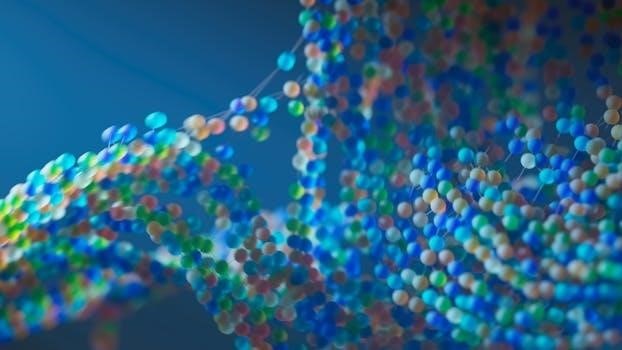Organic Chemistry for Dummies PDF⁚ A Comprehensive Guide
Embark on a journey into the fascinating realm of organic chemistry. This comprehensive guide simplifies complex concepts. It provides accessible explanations, practical examples, and problem-solving techniques. Perfect for beginners and those seeking a refresher, it unlocks the secrets of carbon compounds.
Organic chemistry, the chemistry of carbon compounds, underpins life itself; With over six million known organic compounds, its scope is vast and its importance undeniable. This guide provides a gentle introduction to this complex field, breaking down intricate concepts into manageable pieces. We’ll start with the basics⁚ electrons, protons, nuclei, and photons, the building blocks of matter. Learn to draw Lewis structures and bond-line structures from molecular formulas, visualizing the architecture of molecules.
Understand the significance of chemical formulas and calculate degrees of unsaturation in molecular structures, unlocking clues about molecular composition. Discover resonance structures and why they are crucial for representing molecules accurately. This introduction will lay the foundation for exploring functional groups, alkanes, stereochemistry, and the myriad reactions that govern the behavior of organic molecules. We’ll navigate the nomenclature maze, ensuring you can name and identify organic compounds with confidence. Prepare to be amazed by the elegance and power of organic chemistry.
Importance of Understanding Organic Chemistry
Why is understanding organic chemistry crucial? Because it’s the foundation of countless aspects of our lives. From the medicines that heal us to the plastics that shape our world, organic chemistry plays a central role. It’s essential for understanding biological processes, drug development, materials science, and environmental science. Grasping organic chemistry unlocks the secrets of how molecules interact, react, and transform, enabling innovation in diverse fields.
Consider pharmaceuticals⁚ organic chemists design and synthesize life-saving drugs. In materials science, they create new polymers with tailored properties. In agriculture, they develop pesticides and fertilizers to enhance crop yields. Even in everyday life, understanding organic chemistry helps us make informed decisions about the products we use, from the food we eat to the clothes we wear. Without a solid grasp of organic chemistry, many scientific and technological advancements would be impossible. It’s a key to unlocking a deeper understanding of the world around us.

Fundamental Concepts
Before diving into reactions, grasp the basics. Understand bonding, structure, and nomenclature. Learn how to represent molecules accurately. Master Lewis structures and bond-line drawings. These foundational concepts are essential for success in organic chemistry. They are the building blocks.
Basic Principles of Organic Chemistry
Organic chemistry, at its core, revolves around the unique properties of carbon. Carbon’s ability to form stable bonds with itself and other elements is crucial. This leads to the vast diversity of organic compounds. Understanding these bonding principles is fundamental. This includes single, double, and triple bonds.
Electronegativity plays a vital role in determining bond polarity. Polar bonds influence molecular properties and reactivity. Functional groups are specific arrangements of atoms. They dictate the chemical behavior of organic molecules. Identifying and understanding functional groups is essential for predicting reactions.
Resonance structures represent molecules with multiple possible electron arrangements. They contribute to stability and influence reactivity. Isomers are molecules with the same molecular formula but different structures. Structural isomers differ in their connectivity. Stereoisomers have the same connectivity but different spatial arrangements.
Acids and bases play a crucial role in organic reactions. Understanding acidity and basicity helps predict reaction outcomes. Learn about carbocations, carbanions, and radicals. These reactive intermediates participate in many organic reactions. A solid grasp of these basic principles provides a foundation for success.
Nomenclature of Organic Compounds
Naming organic compounds systematically is crucial for clear communication. The International Union of Pure and Applied Chemistry (IUPAC) provides the standard nomenclature rules. These rules ensure that each compound has a unique and unambiguous name. Start by identifying the parent chain, the longest continuous carbon chain.
Number the carbon atoms in the parent chain to give substituents the lowest possible numbers. Identify and name the substituents attached to the parent chain. Alkyl groups, halogens, and other functional groups are common substituents. Use prefixes to indicate the number of identical substituents (di-, tri-, tetra-).

List the substituents alphabetically, along with their corresponding carbon numbers. If a compound contains a functional group, use the appropriate suffix to indicate its presence. Alcohols end in -ol, ketones end in -one, and carboxylic acids end in -oic acid. Cyclic compounds are named by adding the prefix “cyclo-” to the name of the corresponding alkane.
Bicyclic compounds have more complex naming rules, involving numbering the bridgehead carbons. Practice applying these rules to various organic compounds. Mastering nomenclature enables you to understand chemical literature. It allows you to accurately describe and identify organic molecules. This skill is essential for further study;
Drawing Lewis and Bond-Line Structures
Representing organic molecules visually is essential for understanding their structure and reactivity. Lewis structures show all atoms, bonds, and lone pairs of electrons. To draw a Lewis structure, first determine the total number of valence electrons. Arrange the atoms, typically with the least electronegative atom in the center.
Connect the atoms with single bonds, then distribute the remaining electrons as lone pairs. Ensure each atom (except hydrogen) has an octet of electrons. If necessary, form multiple bonds (double or triple) to satisfy the octet rule. Formal charges can be assigned to atoms to determine the most stable Lewis structure.
Bond-line structures, also known as skeletal structures, are a simplified representation. Carbon atoms are implied at the end of lines and at intersections. Hydrogen atoms bonded to carbon are not explicitly shown. Heteroatoms (atoms other than carbon and hydrogen) are always shown, along with their attached hydrogens.
Lone pairs are often omitted but can be added for clarity. Bond-line structures are quick to draw and emphasize the connectivity of atoms. They are widely used in organic chemistry to represent complex molecules. Practice drawing both Lewis and bond-line structures. This enhances your ability to visualize and interpret organic structures.

Key Topics Covered
Explore the core concepts of organic chemistry, from functional groups and resonance to alkanes and stereochemistry. Understand their properties, reactions, and importance. Master these topics for a solid foundation in organic chemistry and related fields, such as biology and medicine.
Functional Groups in Organic Chemistry
Functional groups are the cornerstone of organic chemistry, dictating the reactivity and properties of molecules. They are specific arrangements of atoms within molecules that undergo characteristic chemical reactions. Understanding these groups is crucial for predicting how organic compounds will behave.
Key functional groups include alcohols (-OH), ethers (R-O-R’), aldehydes (-CHO), ketones (R-CO-R’), carboxylic acids (-COOH), esters (R-COO-R’), amines (-NH2), amides (-CONH2), alkenes (C=C), and alkynes (C≡C). Each group imparts distinct physical and chemical characteristics to the molecule. For instance, alcohols can form hydrogen bonds, impacting boiling points, while alkenes are prone to addition reactions.
Mastering functional groups involves recognizing them within complex structures, understanding their nomenclature, and predicting their reactivity. Predicting reactivity involves considering factors like electronegativity, bond polarity, and steric hindrance. For example, carbonyl groups (aldehydes and ketones) undergo nucleophilic addition reactions.
This knowledge is vital for understanding reaction mechanisms and designing synthetic strategies. By identifying the functional groups present, one can predict the types of reactions a molecule will undergo and the products that will be formed.
Understanding Resonance Structures
Resonance structures are crucial in organic chemistry, representing different ways to depict the electron distribution within a molecule or ion, particularly when a single Lewis structure is inadequate. Resonance isn’t about molecules switching between forms but rather a more accurate representation of electron delocalization.
These structures arise when multiple valid Lewis structures can be drawn for the same arrangement of atoms, differing only in the placement of electrons, specifically pi electrons and lone pairs. The actual molecule is a hybrid, a weighted average of all contributing resonance structures, known as the resonance hybrid. This hybrid is more stable than any single contributing structure.
Drawing resonance structures involves moving electrons, not atoms, indicated by curved arrows. Important rules include maintaining the same sigma bond framework and adhering to the octet rule (or duet for hydrogen). The stability of resonance structures is influenced by factors such as electronegativity, charge distribution, and the number of covalent bonds. Structures with more covalent bonds, less charge separation, and negative charges on more electronegative atoms are generally more stable and contribute more to the hybrid.
Recognizing and drawing resonance structures is essential for understanding reactivity, predicting reaction outcomes, and explaining molecular properties. For instance, resonance can stabilize intermediates and transition states, influencing reaction rates and product distributions.
Alkanes and Stereochemistry
Alkanes, the simplest organic compounds, consist solely of carbon and hydrogen atoms linked by single bonds. They form the backbone of many organic molecules, exhibiting diverse structures from straight chains to branched and cyclic forms. Understanding their properties is fundamental to grasping organic chemistry.
Stereochemistry introduces the concept of three-dimensional molecular structure and its impact on chemical behavior. Isomers, molecules with the same molecular formula but different arrangements, are central to this field. Constitutional isomers differ in connectivity, while stereoisomers have the same connectivity but different spatial arrangements.
Chirality, a key aspect of stereochemistry, describes molecules that are non-superimposable on their mirror images, much like left and right hands. A chiral center, typically a carbon atom bonded to four different groups, is responsible for this property. Enantiomers are stereoisomers that are mirror images of each other.
The Cahn-Ingold-Prelog (CIP) priority rules are used to assign absolute configurations (R or S) to chiral centers, providing a systematic way to distinguish enantiomers. Diastereomers are stereoisomers that are not mirror images. Stereochemistry profoundly influences physical properties, biological activity, and chemical reactivity, making it crucial in drug design and materials science. Understanding alkane structure and stereochemical principles unlocks deeper insights into organic molecule behavior.

Problem-Solving and Practice
Mastering organic chemistry requires diligent problem-solving. Practice is essential to solidify understanding and build confidence. Applying concepts to diverse problems enhances comprehension. Regular practice and review are the keys to success in organic chemistry.
Step-by-Step Approach to Solving Problems
Tackling organic chemistry problems can feel overwhelming. However, a structured, step-by-step approach can significantly simplify the process. Start by carefully reading and understanding the question. Identify the key information and the specific concept being tested. Next, break down the problem into smaller, manageable steps. This could involve drawing reaction mechanisms, identifying functional groups, or applying specific rules of nomenclature.
Consider the reagents involved and their potential reactivity. Draw out the starting material and any relevant intermediates. Use curved arrows to illustrate the movement of electrons during reactions. Keep track of formal charges and stereochemistry. Double-check your work at each step to minimize errors. Finally, review your solution to ensure it logically answers the question and is presented clearly. With consistent application of this method, problem-solving becomes a skill you can master.
Memorization Tricks and Shortcuts
Organic chemistry involves a significant amount of memorization. However, rote learning isn’t always effective. Employing memory tricks and shortcuts can make the process easier and more efficient. For functional groups, create flashcards or use mnemonic devices. Associate each functional group with a vivid image or a short phrase to aid recall. When learning reactions, focus on the underlying mechanisms rather than memorizing individual reactions. This will allow you to predict the outcome of similar reactions.
Use abbreviations and acronyms to represent common reagents and reaction conditions. Develop mind maps to connect related concepts. Regularly review the material to reinforce your understanding. Practice drawing structures repeatedly to improve familiarity. Don’t be afraid to use color-coding to differentiate between different types of atoms or bonds. By incorporating these techniques, you can transform memorization from a chore into an engaging and effective learning strategy. Remember, consistent practice is key.
Practice Exercises and Exam Questions
Mastering organic chemistry requires consistent practice. Working through practice exercises and exam questions is crucial for solidifying your understanding. Start with simpler problems to build confidence. Gradually progress to more challenging questions that require integrating multiple concepts. Utilize textbooks, online resources, and past exams to access a wide range of practice materials.
When solving problems, focus on understanding the underlying principles. Don’t just memorize the answers. Work through each step carefully, showing your reasoning. If you get stuck, review the relevant material before attempting the problem again. After completing each exercise, check your answers and identify any areas where you need further clarification. Simulate exam conditions to prepare for assessments. Time yourself and avoid using any external resources during practice exams. This will help you assess your readiness and identify areas for improvement. Regular practice will enhance your problem-solving skills and boost your confidence.
